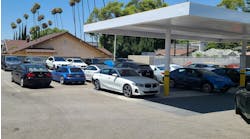Coolant in an engine must do three things: carry heat to the radiator, prevent freezing and protect against corrosion. The glycol-based coolants on the market today can handle the first two tasks almost indefinitely, but corrosion protection relies on chemicals in the coolant that are eventually consumed as they do their job. Corrosion protection has always been a chemical balancing act, and with so many different types of coolant to choose from, it’s getting easy to inadvertently tip the balance the wrong way during cooling system service. Fortunately, it’s not hard to make the right choices, if the technician knows what to look for.
While there are some minor variations, three basic types of coolant are available today: inorganic additive technology (IAT), organic additive technology (OAT) and hybrid organic additive technology (HOAT). To some extent, each will work in any cooling system, but each has been developed to meet car manufacturers’ specific needs for warranty and/or maintenance intervals. Filling a vehicle that was designed for one type of coolant with another type can sometimes cause problems, and the same corrosion protection as the factory fill shouldn’t be expected.
So what happens when coolant that is different from what’s already in the system is added? What happens when a system is drained and refilled with a different coolant? How does one decide which coolant to use?
Corrosion inhibitors
The IAT coolants have been around for generations. They contain silicates that form a protective barrier on everything in the cooling system, even rubber hoses. The newer OAT coolants work very differently. Aluminum and ferrous metals form a surface-layer of corrosion in the presence of moisture, even the little bit of moisture in the air. OAT coolants anneal this metal-oxide layer into a thin surface coating that protects against further corrosion. With either type of inhibitor, there must be enough in the coolant solution to occasionally re-establish the barrier as needed.
Silicates plate out quickly on metal engine parts; thus, the silicates in a coolant solution can drop to less than 20 percent of the starting level in less than 10,000 miles. Another problem with silicates is that, under certain conditions, they can drop out of the solution and form minute deposits.
If this occurs between a shaft and seal, the resulting abrasion will eventually cause a leak. In a cooling system that turns off coolant flow to the heater core when the heater is not in use, silicates can form a gummy deposit that, over the course of a summer season, might clog the core tubes.
So why even use silicates? Because they’re really good at what they do, especially in iron block/aluminum head engines. That’s why some manufacturers still specify using coolants with silicate corrosion inhibitors. It took almost 20 years of OAT development to make a coolant that would effectively protect against corrosion without using silicates at all.
Some of those intermediate products are still in use today. These are the hybrid coolants (HOAT) that use both silicate and organic acid corrosion inhibitors, and one of them is currently the factory fill on all Ford and Chrysler vehicles with gasoline engines. Even in today’s IAT coolants, the silicate concentration has been reduced to only 250 parts per million (PPM), which still provides excellent protection when used as directed.
Those last two words, “as directed,” are more important now than ever, because it’s difficult to know which coolant technology belongs in which vehicle. Look up the coolant specifications in a factory manual or information system, and you’re most likely to see a part number or proprietary name such as “Toyota engine coolant or equivalent.” Because few independent shops buy their coolant from auto dealers, most techs have come to rely on color to identify the coolant.
This, however, is a bad idea, because raw coolant has no color at all. Every manufacturer adds color to the coolant as a dye marker, and they can add any color they want. In fact when red (heavy-duty) and orange (automotive) non-IAT coolants started selling well, some companies began to add similar colors to their coolants with conventional inhibitors and increased their prices. Also, there are green coolants from other countries that are more like OAT or hybrids than IAT coolants.
The IAT coolants intended for heavy-duty diesel engines range from blue to green to purple, and hybrids might be any color at all. Some companies are now dying their coolants yellow regardless of the technology and indicating that it can be “mixed” with any other technology.
Mixing coolants
To quote Dr. Paul Fritz, senior coolants technologist for ChevronTexaco Products Co., “Nothing bad will happen” when two brand-name coolants with different corrosion inhibitor technologies are mixed. By this he means that no sludge will form, there will be no damaging chemical reactions and the coolant will still carry heat and protect against freezing.
However, when adding an IAT to an OAT, the recommended coolant change interval will degrade to that of the shorter-life coolant. Typically, when the mixture stays below 25 percent new coolant on top of 75 percent of the original coolant, the corrosion protection performance will remain that of the original coolant. But as the mix of coolant technologies deepens — that is, if a cooling system has a slow leak and it’s continually topped off with a type of coolant that’s different from what is already in there — eventually the original corrosion inhibitor will be replaced by the new corrosion inhibitor. This will determine the resulting mixture’s overall performance. If someone continues to top off a five-year coolant with a two-year coolant, the resulting coolant mixture should now be changed every two years.
According to Dr. David Turcotte of Valvoline Co., cooling systems are mechanically designed to work with specific types of coolant.
Filling a system with the wrong coolant could cause problems. In a 300-hour test of OAT coolant in a Ford engine designed for HOAT coolant, the water pump impellor and backing plate were seriously damaged by cavitation corrosion.
Turcotte and Fritz both said that it’s not possible to have one product that meets the coolant requirements of all the different automakers. Because some OEMs require silicate-free coolant and others mandate the presence of silicate, “one size does not fit all.”
Maintenance
Both coolant scientists said that cooling system maintenance is more important now than ever before. Dr. Fritz has been working to support and develop extended-life coolants for 10 years, and some of what he’s learned has convinced him that the two most important cooling system maintenance items are freeze point and proper coolant level.
Almost all coolants are formulated to work best at the ideal freeze point mixture, which for most parts of the country means a 50/50 mixture.
Freeze point not only offers the best protection against freezing, but also makes sure the corrosion inhibitors are present at the intended levels. The proper freeze point mixture also is the most effective coolant, because the fluid’s ability to carry heat (heat capacity) is best at a 50/50 mix.
Freeze point is best tested using a refractometer. Other test methods are available, but the refractometer is the most reliable due to its accuracy, its ability to be kept clean and the fact that coolant color does not affect the results.
A vehicle’s cooling system is designed to operate full of coolant. A system that’s constantly low on coolant can be an extremely corrosive environment due to the aggressive nature of the vapors of a glycol/water mix. These steam vapors are more aggressive than either fluid by itself.
After shutting off an engine, the coolant stops flowing and the engine temperature can increase dramatically in localized areas. Keeping the system full can help prevent localized boiling. Checking coolant level by looking at the overflow bottle is not always accurate.
The best way is to remove the radiator cap on a cold engine and make sure the coolant level is correct. If the coolant is low in the radiator, the cap should be checked to ensure it’s working correctly (holding pressure) and that the transfer line to the overflow tank is not clogged.
Water quality also is an important factor. In almost every part of the world, tap water contains minerals like magnesium and calcium that can form deposits in a cooling system, especially on the engine’s hottest parts. These deposits can impede the flow of heat, and if they break loose, they can clog radiator and heater core tubes. Other contaminants such as iron and chlorine are relatively common, and at high enough levels, they can be corrosive.
The only way to avoid minerals and other contaminants in the coolant is to mix it with distilled water instead of tap water. Coolants that are sold premixed are mixed at the factory with distilled water.
When a new metal cooling system part has been installed — for instance, a new water pump — it has no corrosion protection at all. No matter what coolant the system is designed for, the worst thing to do at this point is to reinstall the old coolant. Adding fresh coolant will ensure that there are enough corrosion inhibitors in the coolant to provide protection for the new components.
Regardless of coolant type, adding new coolant is also recommended to avoid contamination from dirt, oil or other chemicals that are common in the repair shop.
Coolant can play a role in repeated heater core failures on the same vehicle, partly because heater core tubes are so thin.
Tap water with a high mineral content or coolant with too much silicate can cause abrasion in the core tubes. High flow rate can cause the same problem, and some vehicles now have restrictors in the heater hoses to slow the coolant flow through the heater core. Coolant that’s intended for heavy-duty diesel engines (high nitrite content) will attack aluminum chemically.
Replacement needed
For most of the history of glycol automotive coolant technology, every car manufacturer has recommended replacing the coolant periodically.
Again, it’s not because old coolant won’t carry heat or protect against freezing, it’s because the corrosion inhibitors literally wear out.
Today’s extended-life coolants work as advertised, but they need two conditions. First, they must be used as instructed and not mixed with a different type of coolant.
Second, the system must be maintained properly as noted earlier, using only the same coolant and distilled water to keep the radiator full. Anything else will reduce the amount of time the coolant will protect against corrosion.
After flushing a cooling system, the brand-name coolants will protect against corrosion as advertised as long as instructions are followed. When adding coolant to top-off a system, it’s best to add the same type of coolant.
Mixing different types of coolant will not cause problems, but once the mixture passes 25 percent, there is really no way to know how long the corrosion protection will last.
Old antifreeze should never be reused when refilling, but distilled water or premixed coolant should.
When considering all that’s in the balance, the few extra dollars one needs to pay for distilled water and fresh coolant are well worth it.




